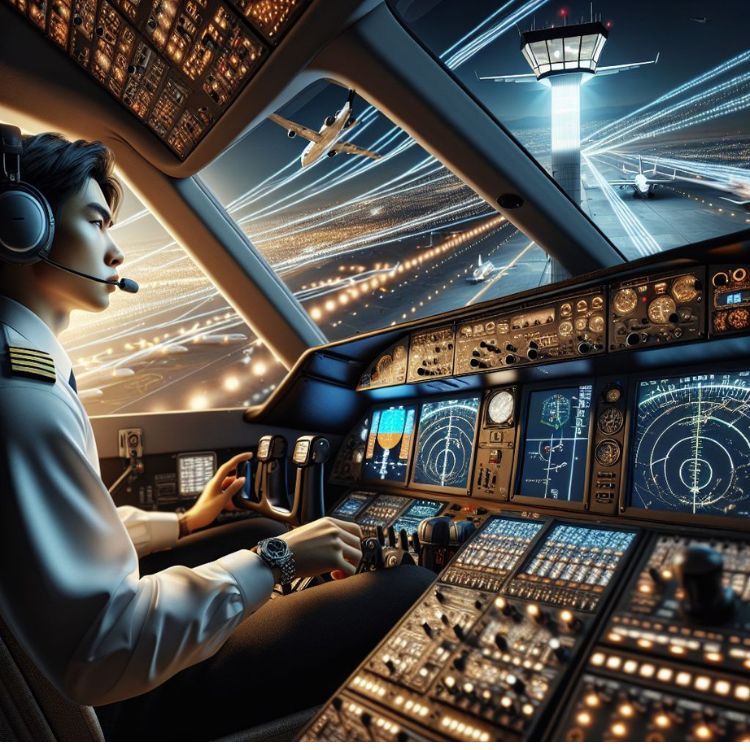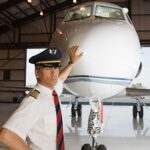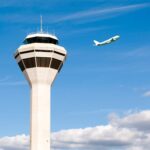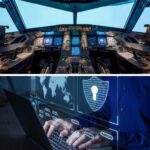
Key Takeaways
- Private jet pilots hold the thrilling responsibility of ensuring passengers’ safety while offering a personalized flying experience.
- Coordination with Air Traffic Control (ATC) is crucial for flight safety, route planning, and navigating different airspaces.
- Training and certifications are extensive, with the Airline Transport Pilot License (ATPL) being a key qualification for private jet pilots.
- Private jet piloting offers a unique set of challenges and rewards, including flexibility, fewer flight hours, and interaction with high-profile clients.
- Effective communication and decision-making are vital skills for pilots, especially in emergencies and changing flight conditions.

Soaring Above Clouds: The Skillful Dance of Private Jet Pilots and ATC
Imagine you’re a maestro, orchestrating a symphony of aircraft across the vast canvas of the sky. This is the everyday reality for private jet pilots who work in unison with Air Traffic Control (ATC) to create harmonious air travel. Each flight is a testament to their skill, precision, and passion for aviation. Now, let’s dive into the details of what makes this profession both challenging and exhilarating.
Understanding the Airborne Symphony
Before we venture into the cockpit, it’s important to grasp the intricacies of air traffic control. ATC is like the conductor of an orchestra, ensuring each aircraft hits the right notes at the right time to avoid any discord. Pilots rely on ATC for safe passage through the skies, just as musicians rely on their conductor to create beautiful music.
The Life of a Private Jet Pilot
As dawn breaks, the private jet pilot begins their day. It’s not just about flying; it’s about crafting an experience. Each mission is different – from the destinations to the faces that greet them. They’re not just pilots; they’re custodians of a journey, guardians of the skies. Let’s peek into their world.
Pre-Flight Precision: Planning and Coordination
Long before the engines roar to life, the pilot’s work begins. Planning is the first step, and it’s as critical as the flight itself. Pilots meticulously chart the course, considering factors like weather, fuel needs, and the performance of their jet. They also coordinate with ground crews and ATC to ensure everything is set for a smooth takeoff. This groundwork is the foundation of a successful flight.
Mastering the Controls: Flying Duties and Responsibilities
Once airborne, the pilot’s focus shifts to navigating the skies. They must be adept at reading instruments, making adjustments, and staying vigilant. But flying is more than technical skill; it’s an art. Pilots must be able to adapt to the unexpected, whether it’s a sudden storm or a change in flight plans. They are the ultimate decision-makers, ensuring the safety and comfort of everyone on board.
The cockpit of a private jet is a sanctuary of control and concentration. Here, every switch and gauge has a purpose, and the pilot knows them all like the back of their hand. In this space, split-second decisions are made, and pilots must trust their training and instincts to navigate the skies safely.
“Flying is the second greatest thrill known to man… Landing is the first!” – Anonymous
Let’s continue our journey into the world of private jet pilots and the air traffic control that keeps them on course.
Earning Your Wings: What It Takes to Become a Private Jet Pilot
To become a private jet pilot, you must first lay a solid foundation with the right training. Start with obtaining your Private Pilot License (PPL), which is your entry ticket into the world of aviation. But the journey doesn’t stop there. You’ll need to rack up hours, experience, and additional ratings, like the Instrument Rating (IR) and Multi-Engine Rating (ME), which are essential for flying sophisticated private jets.
After building experience, the next milestone is the Airline Transport Pilot License (ATPL). This is the gold standard for pilots and requires passing rigorous written exams, accumulating a significant number of flight hours, and demonstrating expert flying skills. The ATPL is your passport to the captain’s seat, signifying that you’ve mastered the art of flying.
But obtaining your licenses and ratings is just the beginning. Private jet pilots often go above and beyond, seeking out specialized training that hones their skills for the unique demands of private aviation. This could include training for specific aircraft types, learning advanced safety techniques, or even customer service excellence to cater to their elite clientele.
“The engine is the heart of an airplane, but the pilot is its soul.” – Walter Raleigh
Staying Sharp: Ongoing Training Regimens
Training for a private jet pilot is never really complete. The skies are constantly changing, and so are the technologies and regulations that govern them. To stay sharp, pilots must engage in ongoing training. This includes regular simulator sessions to practice emergency procedures, staying up-to-date with the latest navigation systems, and participating in recurrent training to refresh their knowledge and skills.
The Sky’s the Limit: The Career of a Private Jet Pilot
The career of a private jet pilot is both glamorous and demanding. It offers a level of autonomy and variety that’s rare in the workforce. One day, you might be flying to a remote tropical island; the next, you’re heading to a bustling metropolis. The passengers you serve are as diverse as the destinations, from celebrities to business moguls, each expecting a seamless and discreet service.
Despite the allure, the job comes with its own set of challenges. Private jet pilots often work on call, which means their schedule can be unpredictable. They must be ready to fly at a moment’s notice, which requires a flexible lifestyle and a passion for the job that goes beyond the paycheck. Yet, for those who love to fly, these challenges are part of the adventure.
“To most people, the sky is the limit. To those who love aviation, the sky is home.” – Jerry Crawford
For private jet pilots, the career trajectory can be steep, but the rewards are sky-high. With experience, pilots can progress to flying larger and more sophisticated aircraft, take on leadership roles, or even become a chief pilot, overseeing flight operations for an entire fleet.
Adapting to Altitude: Overcoming Challenges in Aviation
Adapting to the dynamic nature of aviation is part of a private jet pilot’s DNA. They must be proficient in dealing with technical malfunctions, unexpected weather changes, and even medical emergencies mid-flight. This adaptability is not just about handling stress; it’s about embracing it and turning challenges into successful outcomes.
Exclusive Skies: Catering to High-Profile Clients and their Unique Needs
Catering to high-profile clients is not just about flying them from point A to point B. It’s about providing an experience that’s as exclusive as the skies they’re flying through. Discretion, personalized service, and an understanding of the nuances of luxury travel are all part of the day-to-day responsibilities of a private jet pilot.
Pilot’s Checklist: Daily Routines and Safety Protocols
- Conduct thorough pre-flight inspections to ensure aircraft safety and readiness.
- Review weather forecasts and adjust flight plans accordingly.
- Communicate with ATC to obtain clearances and discuss route options.
- Ensure the cabin is prepared for the passengers’ comfort and safety.
- Remain vigilant for any mechanical issues or warning signs during the flight.
Every day, the pilot’s checklist is their roadmap to a successful flight. It’s a non-negotiable ritual that ensures no detail is overlooked. Safety is the cornerstone of aviation, and this checklist is the pilot’s commitment to upholding it, every time they take to the skies.
Throughout the day, a private jet pilot’s attention to detail is what sets them apart. They check and double-check everything from fuel levels to the integrity of the emergency equipment. It’s this meticulous nature that makes them trusted professionals in the eyes of their passengers and peers.
After a day’s journey, as the engines wind down and the cabin doors open, the pilot’s duty doesn’t end. They debrief with the crew, review any issues that arose, and begin preparations for the next flight. It’s a cycle of relentless dedication to their craft and their passengers’ well-being.
Routine Rigor: Pre-Flight Inspections and Risk Management
For a private jet pilot, the pre-flight inspection is a sacred ritual. It’s not just about walking around the aircraft; it’s about engaging with the machine, understanding its language, and ensuring it’s fit to take to the skies. This is when pilots assess risks, manage potential threats, and make critical decisions to mitigate them.
Guardians of the Galaxy: In-Flight Monitoring and Decision Making
Once in the air, pilots become the guardians of their own galaxy – the aircraft and its occupants. They monitor every aspect of the flight, from the engines’ hum to the subtle shifts in weather patterns. They are constantly making decisions, always with the safety and comfort of their passengers as their guiding star.
So, as you dream of the skies, remember that the life of a private jet pilot is a tapestry of skill, dedication, and passion. It’s a career that’s as challenging as it is rewarding, and for those who hear the call of the skies, it’s a calling that’s impossible to ignore.
For those with their eyes on the skies, the allure of becoming a private jet pilot is undeniable. It’s a role that demands precision, professionalism, and a deep passion for flying. As we continue to explore the multifaceted life of these elite aviators, let’s delve into the essential routines and safety protocols that ensure their passengers’ journeys are not just luxurious but also safe.
Pilot’s Checklist: Daily Routines and Safety Protocols
Every flight begins with a pilot’s unwavering commitment to safety. From the initial weather check to the final shutdown of engines, meticulous attention to detail is what distinguishes the exceptional from the average. Here’s an inside look at the daily routines and safety protocols that private jet pilots adhere to:
Routine Rigor: Pre-Flight Inspections and Risk Management
The day for a private jet pilot starts long before takeoff. With a steaming cup of coffee in hand, they perform a ritual as timeless as aviation itself: the pre-flight inspection. This is a thorough examination of the aircraft’s exterior and interior, ensuring everything is in perfect working order. It’s a dance of diligence, where pilots check the tires for wear, the engines for leaks, and the surfaces for any signs of damage.
But it’s not just about the hardware. The pilot also reviews the day’s flight plan, analyzes weather reports, and strategizes fuel management. Risk assessment is a continuous process, and the pilot must anticipate and prepare for any scenario. By the time passengers step on board, every detail has been accounted for, ensuring a flight that’s as smooth as it is safe. Learn more about the life of a private jet pilot.
Guardians of the Galaxy: In-Flight Monitoring and Decision Making
As the aircraft ascends, the pilot transitions from pre-flight planner to in-flight guardian. The cockpit becomes a sanctuary of vigilance, where every gauge and alert is closely monitored. The pilot is in constant communication with ATC, receiving updates and instructions to maintain the flight’s safety and efficiency.
In the rare event of an emergency, the pilot’s training kicks in instinctively. They are equipped to handle everything from technical malfunctions to unexpected weather changes. It’s this unwavering focus and ability to make split-second decisions that ensures each flight is not just a journey, but a testament to the pilot’s expertise.
Frequently Asked Questions (FAQ)
How Do Private Jet Pilots Coordinate with Air Traffic Control?
Private jet pilots and ATC are in continuous dialogue. Pilots provide their flight plans to ATC, who then clear paths, manage traffic, and provide updates on weather or hazards. This partnership is built on trust and professionalism, ensuring that every flight is choreographed to perfection.
What Training is Necessary to Become a Private Jet Pilot?
To become a private jet pilot, one must first obtain a Private Pilot License (PPL) and then build flight experience to qualify for a Commercial Pilot License (CPL). From there, obtaining an Airline Transport Pilot License (ATPL) is the ultimate goal, allowing pilots to command private jets. Ongoing training and certifications are crucial to stay current in this ever-evolving field.
What are the Main Responsibilities of a Private Jet Pilot?
A private jet pilot’s responsibilities extend far beyond flying. They’re tasked with flight planning, aircraft safety checks, and navigation. They must also provide a bespoke service to clients, ensuring comfort and discretion. Ultimately, the pilot’s primary duty is the safety of everyone on board.
How Does a Private Jet Pilot Communicate in an Emergency?
In an emergency, clear and concise communication is key. Private jet pilots are trained to use standard aviation phraseology to convey their situation to ATC, who then provide assistance. Pilots also have protocols in place for onboard communication to manage passengers and crew.
What Makes Private Jet Piloting Different from Commercial Flying?
Private jet piloting is distinct from commercial flying in its personalized approach to service, flexible scheduling, and often more varied destinations. Pilots enjoy closer relationships with clients and have greater autonomy over flight operations, providing a tailored and intimate flying experience.
Embarking on a career as a private jet pilot is a journey of relentless dedication, continuous learning, and an unwavering commitment to excellence. It’s a path that leads not just across the skies, but into the hearts of those who pursue it. For the aviation enthusiast, it’s a calling that resonates with the very essence of freedom and adventure. Ready for a new level of travel? Click here to request a quote or begin your extraordinary journey: Start Your Adventure.













